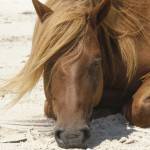Study Confirms Positive Long-Term Outcomes After Colic Surgery

Owners must often make split-second decisions when it comes to agreeing to surgery for colicky horses. Having data regarding long-term chances of survival, return to athleticism, and owners’ satisfaction after surgery would be immensely valuable when making care decisions. With this in mind, Washington State University veterinarians reviewed data from horses that underwent colic surgery over seven years.*
Survival Data
Of 185 horses that had surgery, 72% (134 horses) recovered from anesthesia, and 79% of those horses (106 of 134) survived to discharge.
“Next, follow-up information was collected for 71 of the 106 surviving horses. Just over 85% of those horses were still alive one year after discharge from the hospital,” explained Katie Young, Ph.D., a Kentucky Equine Research nutritionist.
Return to Performance
In terms of athleticism, 59 of the 71 horses (83%) with available follow-up data were engaged in some athletic activity before their surgery. Of the 61 horses still alive one year after surgery, almost three-quarters (44 horses or 72.1%) were athletically active. Only one horse was reportedly retired from athletic activity due to postsurgical complications.
“These data show that if a horse survives until hospital discharge, then it is highly likely to remain alive and be athletically active one year later,” explained Young.
An overwhelming 75.4% of surveyed owners said they would perform colic surgery on another horse in a similar situation. Unsure owners said their decision would “depend on the horse and personal situation at that time, due to the significant financial and emotional investment required.”
“Although one year was considered “long-term” in this study, additional data with longer follow-up would be of great benefit in assisting owners in making decisions in emergencies,” Young noted.
Types of Colic and Preventative Measures
In this retrospective colic study, the large intestine was most commonly affected, responsible for 55% of all colic cases. Specific diagnoses included large colon impactions, displacements, and twists in addition to lesions affecting the cecum.
There are no clear-cut ways to completely avoid colic in horses, but nutrition and management choices can help reduce the risk of digestive disturbances.
“Nutritional management includes feeding protocols to reduce the risk of excessive nonstructural carbohydrates (NSCs) escaping digestion in the small intestine and reaching the hindgut. In such cases, rapid fermentation of NSC in the hindgut can result in excess gas and acid production, resulting in hindgut acidosis,” said Young.
Feeding management protocols designed to prevent hindgut acidosis and therefore colic include the following:
- Providing small, frequent meals;
- Ensuring concentrate meals contain no more than 2-4 g starch per kg body weight to avoid overloading the small intestine with NSCs;
- Making all feeding changes gradually; and
- Providing adequate quality forage to maintain a healthy gut.
“EquiShure is a digestive health supplement designed for horses either suffering from or at risk for hindgut acidosis. Encapsulation technology ensures targeted delivery and release of sodium bicarbonate buffer to the hindgut to stabilize the pH and microbial environment and reduce the risk of hindgut acidosis and colic,” shared Young.
*Matthews, L.B., M. Sanz, and D.C. Sellon. 2023. Long-term outcome after colic surgery: Retrospective study of 106 horses in the USA (2014-2021). Frontiers in Veterinary Science 10:1235198.








